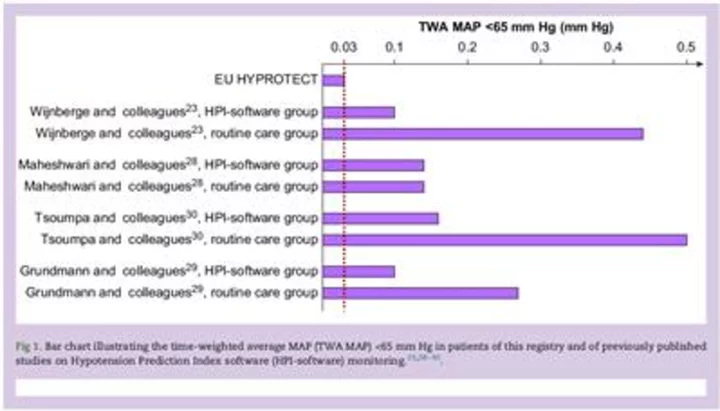NEWBURY, England--(BUSINESS WIRE)--Aug 14, 2023--
Edwards Lifesciences today announced the results of the EU-HYPROTECT registry which indicates that using Acumen HPI software may help reduce the duration and severity of intraoperative hypotension in patients having non-cardiac surgery.
This press release features multimedia. View the full release here: https://www.businesswire.com/news/home/20230811852489/en/
Bar chart illustrating the time-weighted average MAP (TWA MAP) <65 mm Hg in patients of this registry and of previously published studies on Hypotension Prediction Index software (HPI-software) monitoring. (Graphic: Business Wire)
EU-HYPROTECT is a European multicenter prospective observational registry which included in its final analysis 702 patients scheduled for elective major non-cardiac surgery in 12 medical centers in 5 countries (France, Germany, Italy, Spain, UK). It is the first multicenter registry involving a predictive monitoring technology, establishing a large, prospectively collected data base on hypotension management in patients having non-cardiac surgery. All patients had intraarterial blood pressure monitoring with an arterial catheter and intraoperative Acumen HPI software.
Both the duration and severity of intraoperative hypotension are associated with
postoperative complications. The primary endpoint of this registry, therefore, was intraoperative hypotension quantified using the time-weighted average mean arterial pressure (MAP) <65 mmHg. Secondary endpoints included the proportion of patients with at least one ≥1-min-episode of a MAP <65 mmHg, and the number of ≥1-min-episodes of a MAP <65 mmHg.
Between September 2021 and May 2022, 749 patients were enrolled in the registry and 702 included in the final analysis. The median time-weighted average MAP <65 mmHg was 0.03 (0.00, 0.20) mmHg. 285 patients (41%) had no ≥1-min-episode of a MAP <65 mmHg – 417 patients (59%) had at least one. The median number of ≥1-min-episodes of a MAP <65 mmHg was 1 (0, 3).
In addition, although the study was not powered for this outcome, the incidence of acute kidney injury was at the lower end of what is reported in patients having major non-cardiac surgery.
In Europe, of the 2.5 million patients undergoing high-risk surgery annually, one in four develops serious postoperative complications 1,2. Throughout the hospital patient journey, anaesthetists and intensivists need to analyse large amounts of data to make life-critical decisions for patients. One example is critical drops in blood pressure known as hypotension. Intraoperative hypotension is common in patients having non-cardiac surgery under general anaesthesia 3. Intraoperative hypotension is associated with increased mortality and major postoperative complications (myocardial injury, acute kidney injury) (4-8).
These postoperative complications come with a significant cost burden for healthcare systems as they are linked with rehospitalisations and increased morbidity. 9
“ Tackling intraoperative hypotension is a critical task for anesthetists. Systems have been used in operating rooms and intensive care units to monitor blood pressure and other vital signs for decades. However, with these technologies,intraoperative hypotension is sometimes not detected, and when it is, the treatment is reactive, potentially after blood pressure has already dropped below safe levels ”, Dr Simon James Davies, Honorary Consultant in Anaesthesia and Perioperative Medicine, York and Scarborough NHS Foundation Trust.
Edwards Lifesciences has developed the Acumen HPI software, which provides clinicians with information regarding the likelihood that a patient will develop hypotension. Based on an algorithm that calculates data from hemodynamic monitoring in perioperative management, it leverages predictive analytics to alert clinicians of potential blood pressure drops before they occur.
“Predictive hemodynamic monitoring may be a promising approach to improve patient safety and outcomes. Clinicians need innovations that can support complex clinical decision making in order to improve quality of care.” comments Dr S J Davies.
“The consequences of the COVID-19 pandemic have drastically accelerated the need for solutions that improve patient safety and outcomes, reduce hospital length of stay and increase hospital efficiencies. The results of the EU-HYPROTECT registry are promising and demonstrate the need to better monitor hypotension in the perioperative pathway. Improving patient safety and outcomes is our ultimate goal and we believe the use of predictive monitoring can help achieve this.” comments Pr Thomas Scheeren, Senior Director Medical Affairs EMEACLA at Edwards Lifesciences.
The full results of the EU-HYPROTECT registry were published in the British Journal of Anaesthesia and can be consulted on https://www.bjaopen.org/article/S2772-6096(23)00019-9/fulltext
About Edwards Lifesciences
Edwards Lifesciences is the global leader of patient-focused innovations for structural heart disease and critical care monitoring. We are driven by a passion for patients, dedicated to improving and enhancing lives through partnerships with clinicians and stakeholders across the global healthcare landscape. For more information, visit www.Edwards.com and follow us on Twitter @EdwardsLifesci.
Edwards, Edwards Lifesciences, the stylized E logo, Acumen, Acumen HPI, HPI and Hypotension Prediction Index are trademarks of Edwards Lifesciences Corporation and its affiliates. All other trademarks are the property of their respective owners. This statement is made on behalf of Edwards Lifesciences Corporation and its subsidiaries.
###
References:
1 Preoperative Score to Predict Postoperative Mortality – POSPOM Edward’s Presentation
2 Ghaferi AA et al. Variation in hospital mortality associated with inpatient surgery. N Engl J Med, 2009.
3 Bijker JB, van Klei WA, Kappen TH, van Wolfswinkel L, Moons KG, Kalkman CJ: Incidence of intraoperative hypotension as a function of the chosen definition: literature definitions applied to a retrospective cohort using automated data collection. Anesthesiology 2007, 107(2):213-220.
4 Gregory A, Stapelfeldt WH, Khanna AK, Smischney NJ, Boero IJ, Chen Q, Stevens M, Shaw AD: Intraoperative Hypotension Is Associated With Adverse Clinical Outcomes After Noncardiac Surgery. Anesth Analg 2020.
5 Salmasi V, Maheshwari K, Yang D, Mascha EJ, Singh A, Sessler DI, Kurz A: Relationship between Intraoperative Hypotension, Defined by Either Reduction from Baseline or Absolute Thresholds, and Acute Kidney and Myocardial Injury after Noncardiac Surgery: A Retrospective Cohort Analysis. Anesthesiology 2017, 126(1):47- 65
6 Sessler DI, Khanna AK: Perioperative myocardial injury and the contribution of hypotension. Intensive care medicine 2018, 44(6):811-822
7 Sun LY, Wijeysundera DN, Tait GA, Beattie WS: Association of Intraoperative Hypotension with Acute Kidney Injury after Elective Noncardiac Surgery. Anesthesiology 2015, 123(3):515-523.
8 Walsh M, Devereaux PJ, Garg AX, Kurz A, Turan A, Rodseth RN, Cywinski J, Thabane L, Sessler DI: Relationship between intraoperative mean arterial pressure and clinical outcomes after noncardiac surgery: toward an empirical definition of hypotension. Anesthesiology 2013, 119(3):507-515
9 Vonlanthen R, Slankamenac K, Breitenstein S, Puhan MA, Muller MK, Hahnloser D, Hauri D, Graf R, Clavien PA. The impact of complications on costs of major surgical procedures: a cost analysis of 1200 patients. Ann Surg. 2011 Dec;254(6):907-13. doi: 10.1097/SLA.0b013e31821d4a43. PMID: 21562405.
View source version on businesswire.com:https://www.businesswire.com/news/home/20230811852489/en/
CONTACT: Media Contact:
Julie Tracol
Julie_tracol@edwards.com
+41 (0)75 431 74 95
KEYWORD: UNITED KINGDOM EUROPE
INDUSTRY KEYWORD: CARDIOLOGY SOFTWARE BIOTECHNOLOGY SURGERY HEALTH MEDICAL DEVICES HEALTH TECHNOLOGY TECHNOLOGY
SOURCE: Edwards Lifesciences
Copyright Business Wire 2023.
PUB: 08/14/2023 07:29 AM/DISC: 08/14/2023 07:29 AM
http://www.businesswire.com/news/home/20230811852489/en









